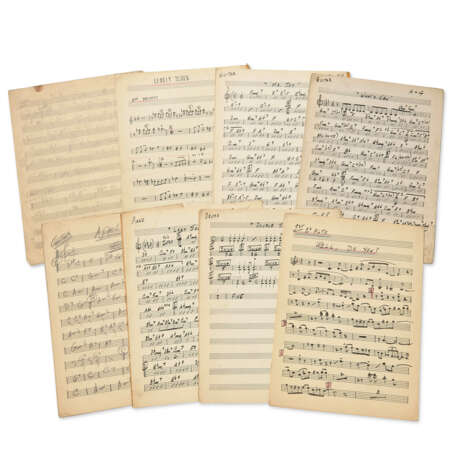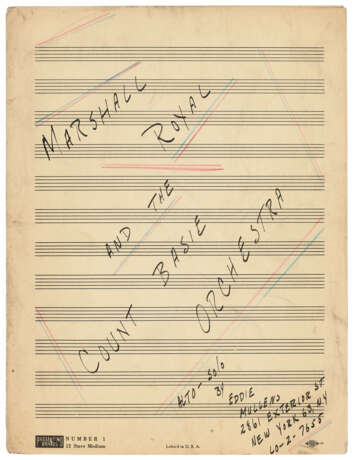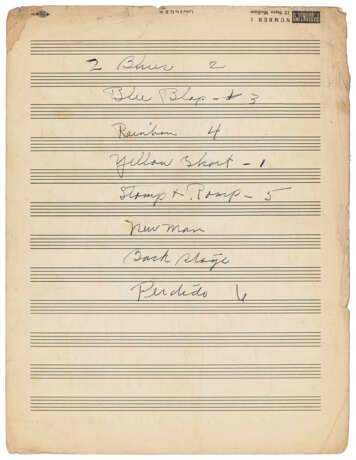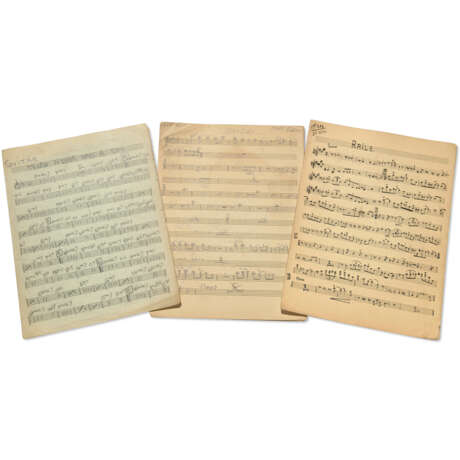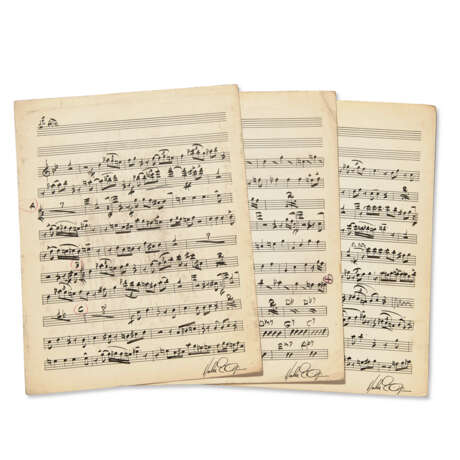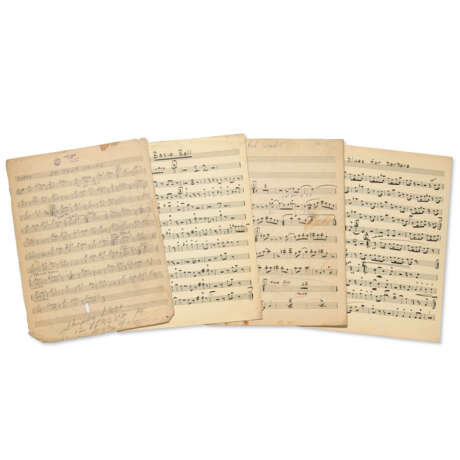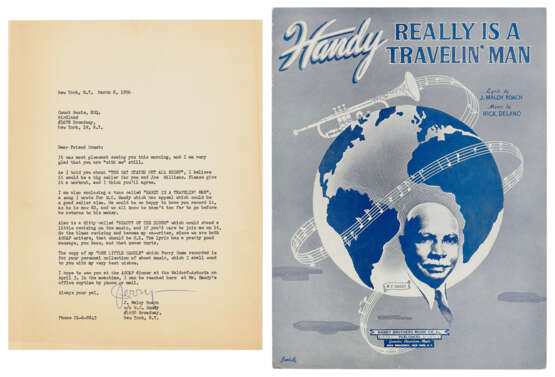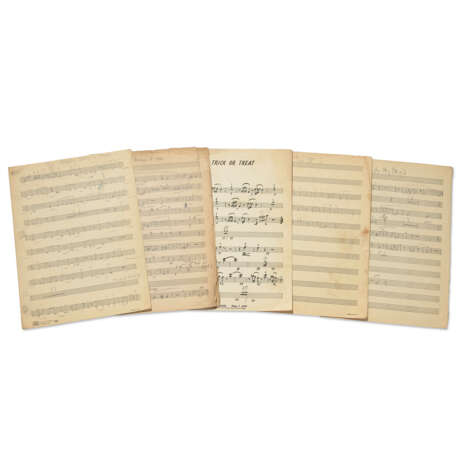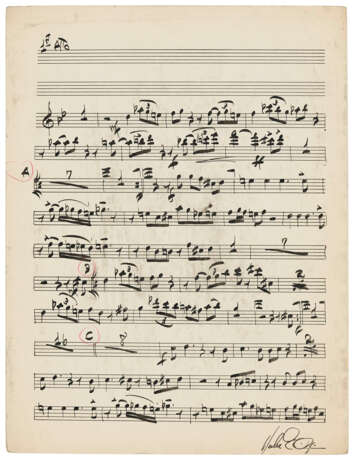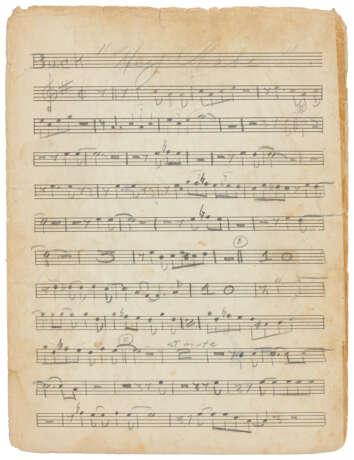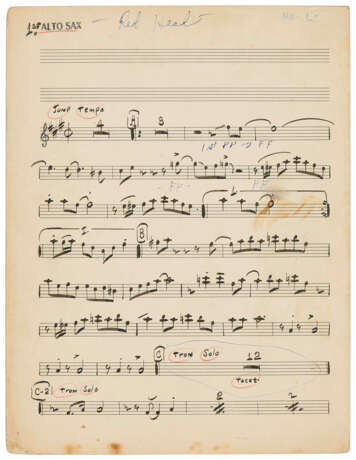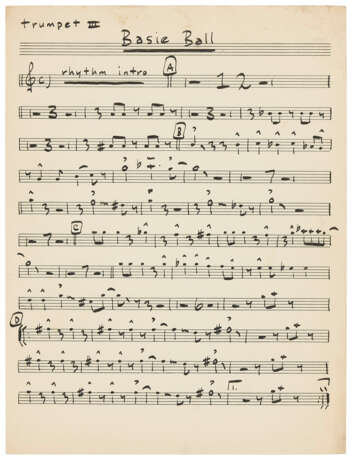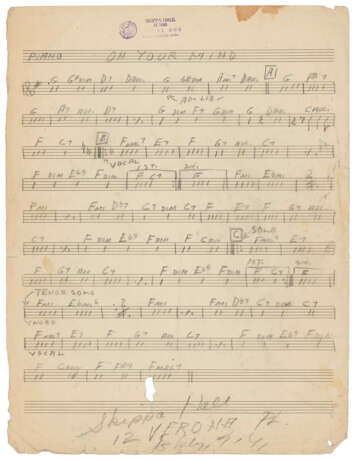A remarkable archive of manuscript arrangements from the founding years of Count Basie’s “New Testament” band, in the hands of Neal Hefti, Ernie Wilkins, Frank Foster, Benny Golson, Charles Thompson and others, 1940s-50s
28.09.2023 13:00UTC +00:00
Classic
Startpreis
30000GBP £ 30 000
| Auctioneer | CHRISTIE'S |
|---|---|
| Veranstaltungsort | Vereinigtes Königreich, London |
| Aufgeld | see on Website% |
Archiv
Die Auktion ist abgeschlossen. Es können keine Gebote mehr abgegeben werden.

ID 1016382
Los 162 | A remarkable archive of manuscript arrangements from the founding years of Count Basie’s “New Testament” band, in the hands of Neal Hefti, Ernie Wilkins, Frank Foster, Benny Golson, Charles Thompson and others, 1940s-50s
Schätzwert
£ 30 000 – 50 000
William J. “Count” Basie
BASIE, William J. “Count” (1904-1984), et al.
A remarkable archive of manuscript arrangements from the founding years of Count Basie’s “New Testament” band, in the hands of Neal Hefti, Ernie Wilkins, Frank Foster, Benny Golson, Charles Thompson and others, 1940s-50s.
One of the greatest bandleaders in jazz history, Count Basie led a big band from 1935, almost without interruption, until his death nearly 50 years later. As jazz critic William Ruhlmann notes, ‘Basie's orchestra was characterized by a light, swinging rhythm section that he led from the piano, lively ensemble work, and generous soloing. Basie was not a composer… his instrument was his band, which was considered the epitome of swing and became broadly influential on jazz.’
A decline in the popularity of swing music, along with an industry-imposed recording ban in 1948, forced Basie to break up his full orchestra in 1949, opting to front an octet for the next couple of years. This brief hiatus distinguished the two major Basie band eras as the ‘Old Testament’ and ‘New Testament’. By Spring 1951, Basie was able to begin reforming his orchestra, which became known as the ‘New Testament’ band, when Birdland founder Morris Levy offered him an open-ended residency. In Godfather of the Music Business, Richard Carlin writes, ‘According to some people – including Basie himself – Levy was central in reviving Basie's band... By guaranteeing Basie regular work at Birdland, Levy lay the groundwork for the resurrection of the band." Producer Norman Granz backed the band’s resurgence when he signed Basie to his Clef label later that year.
Not a composer himself, Basie encouraged his musicians to compose and arrange specifically for the orchestra and its distinctive soloists. Arranger Neal Hefti, along with Basie’s main in-house arrangers, saxophonists Frank Foster and Ernie Wilkins, the latter described by Marshal Royal as ‘a great writer, one of the best there ever was’, helped to define the band’s new smooth, melodic sound and broaden the Basie repertoire. Basie recalled ‘we had all that wonderful stuff that was being worked up by writers that we already had right there playing in the band, and Neal Hefti and a few others were also bringing their things from the outside,’ and described first meeting Hefti ‘Neal came by, and we had a talk, and he said he’d just like to put something in the book. Then he came back with Little Pony and then Sure Thing, Why Not? and Fawncy Meeting You and we ran them down, and that’s how we got married.’ Basie’s oversight, direction, and ability to distil a song to its essentials remained key. Speaking to Jazz at Lincoln Center Radio in 2010, co-author of Basie’s autobiography Albert Murray revealed ‘Count Basie never did sit down and compose a piece on paper – he would compose on the band… He would compose by just feeding themes, and then revising. No matter what you brought in, eventually, he would be the collaborator.’ Frank Foster elaborated ‘Basie was as much an arranger as any of the arrangers who wrote down the notes and brought in the charts, once he listened to it, and figured out what was wrong with it -- what was too busy, and what needed to be removed.’
Discovered in an anonymous storage locker in Chicago, this trove of manuscript parts and arrangements, primarily dating from the early 1950s, evidently form a portion of the treasured working “book” of Basie’s New Testament band, shedding light on the feverishly creative and intensely collaborative founding phase of the band, which cemented the sound and style Basie was to employ for the remainder of his career. Outside of institutional archives, such a collection of manuscript music for one of the greats of the Big Band era is extraordinarily rare. The original holder of the archive remains elusive, although several documents point either to Basie himself, or to lead saxophonist and music director Marshal Royal. With at least eight pieces in Hefti’s hand and several in the hand of Ernie Wilkins, Basie’s most important outside and in-house collaborators are strongly represented, while other notable highlights include pieces by Frank Foster, legendary tenorist Benny Golson, Old Testament player turned arranger Buck Clayton, five two-page parts for an arrangement of Dizzy Gillespie and Buster Harding’s Rails, and two parts for Sy Oliver’s Redhead, one of the signature Basie tunes of the new era. This Basie period is well documented on the 2005 Mosaic Records 8-CD compilation The Complete Clef/Verve Count Basie Fifties Studio Recordings. (Basie and Murray, Good Morning Blues 389. Carlin, Morris Levy. Royal and Gordon, Jazz Survivor 89-104. Ruhlmann, Basie, in Bogdanov ed. All Music Guide. Murray and Foster on JALC Radio, Distilling the Blues, broadcast 16 September 2010.)
Partial arrangements for 31 compositions, totalling 48 parts, each part on one to 4 pages of predominantly ten or twelve stave paper, approximately 88 pages in total, comprising:
- BASIE, William J. “Count” (1904-1984). A set list in Basie’s hand on the reverse of a single page piano part in the hand of Neal Hefti for the Ernie Wilkins composition Paul Meets Pres, c.1951. The set list includes Perdido and Blee Bop Blues, the latter of which was reissued in 1952 as Normania in tribute to Norman Granz;
- CLAYTON, Wilber Dorsey “Buck” (1911-1991). Down for the Double by Freddy Green – two-page 1st trumpet part;
- FOSTER, Frank (1928-2011). There Never Was a Day – one-page guitar part, with an untitled score in Neal Hefti’s hand verso;
- GOLSON, Benny (b.1929). Soft Touch – two-page guitar and 2nd trombone parts, with the legendary tenorist and arranger’s Local 274 stamps, dated 1954;
- GILLESPIE, John Birks “Dizzy” (1917-1993) and Buster HARDING (1917-1965). Rails – two-page parts for 1st alto, 3rd tenor, 1st trumpet, 4th trumpet and 3rd trombone for the Gillespie and Harding composition, possibly in the hand of Dizzy Gillespie, c.1953, recorded by Basie in 1954;
- GIBSON, Albert “Andy” (1913-1961). Hoo Day – an unknown autograph composition by the trumpeter and arranger, whose work featured on Basie’s 1952 album The Count!;
- HARDING, Lavere “Buster” (1917-1965). Big Joe – two-page 1st trombone, 1st alto and 4th trumpet parts for Harding’s composition, possibly in the composer’s hand; The Hobnail Boogie – two-page baritone part for his composition, possibly in his hand; Howzit – two-page 2nd trumpet part of Harding’s composition, possibly in his hand, recorded in 1951;
- HEFTI, Neal (1922-2008). Blues -- one-page piano part; Mr. Jay -- four-page guitar and piano parts; What’s New? -- two-page guitar part; April in Paris – one page guitar part, with a two-page guitar part in an unknown hand, possibly that of Freddie Green; Lazy Sal – three-page piano part; Double Shot – one-page drum part; Hey Rube by Sir Charles Thompson – three-page baritone part; Well Do You? – two-page 1st alto and 5th baritone parts, with single-page scores for the same instruments in the hand of Ernie Wilkins verso;
- JOHNSON, Sivert “Sy” Bertil (1930-2022). Basie Ball – two-page 3rd trumpet part, with pianist, composer and arranger Sy Johnson’s Local 47 stamp to last page; Blues for Barbara by Wild Bill Davis – two-page baritone part, with Johnson’s Local 47 stamp;
- McRAE, Dave. Redhead by Sy Oliver – two-page 1st alto and 5th baritone parts, with saxophonist and arranger McRae’s Local 802 stamp, first recorded by the Basie band in 1952;
- PRICE, Charles Q. Moonlight – one-page 1st and 4th trumpet, and 1st alto parts, with stamped credit of saxophonist and arranger Charles Q. Price, dated 1944; with a two-page 3rd trumpet part and one-page 1st trombone part for two unidentified tunes;
- THOMPSON, “Sir” Charles (1918-2016). Hey Rube – three-page trumpet part for Thompson’s composition in his own hand, the part marked for ‘Buck’ [Clayton], first performed by Basie in 1946;
- THOMPSON, Ernest. Mean To Me – two-page 3rd trumpet part marked for ‘Snookie’ [Snooky Young], with Thompson’s Local 802 stamp. Trumpeter Snooky Young, known for his mastery of the plunger mute, briefly joined Basie in 1942, re-joining the band from 1945 to 1947, and again from 1957 until 1962;
- WILKINS, Ernest “Ernie” Brooks, Jr. (1922-1999). Double Shot – one-page 1st alto part; Basie’s Back In Town – three-page baritone part of his own composition; Because of You by Basie altoist Tab Smith – one-page baritone and 1st trumpet parts; On My Mind – one-page 4th trumpet part; a one-page trumpet part for an unknown composition; with a two-page 2nd trumpet part for the Wilkins composition Trick or Treat, transcribed by The Music Tailors of New York, with additional notations in the hands of Wilkins and Wendell Culley; and a one-page 4th trumpet part for an unidentified arrangement;
- a two-page trumpet part in an unknown hand for the Hy Heath composition Walking Slowly Behind You, recorded by Basie in 1949, the part marked for Emmett Berry, who played trumpet with Basie 1945-50;
accompanied by three supporting documents which point directly to Count Basie and his organisation, comprising:
- a music cover sheet formed from a bifolium of stave paper titled diagonally in black ink on the front in Hefti’s hand ‘Marshall [sic] Royal and the Count Basie Orchestra – Alto solo by Eddie Mullens’;
- a handwritten cover for a score submitted to Basie when he was performing in San Francisco, the cover sheet on a single page of stave paper, addressed in pencil from the film score composer Fred Karlin while he was a student at Amherst College ‘to Count Basie c/o The Macumba Club, San Francisco’;
- a typed letter from W.C. Handy’s agent J. Maloy Roach, signed ‘Jerry’, to ‘My Friend Count’, suggesting some songs including one that he wrote for Handy, ‘who would be so happy to have you record it, as we all know he hasn’t too long before he returns to his maker’, and enclosing the printed sheet music to Handy really is a Travelling Man;
together with a collection of partial arrangements for 24 compositions with connections to other bands of the period, in the hands of Skippa Hall, Billy May, Buddy Hiles, Howard Kravitz, Billy Browne Moreno, Thomas H. Phillips, A.K. Salim, Charlie Mariano, Bobby Smith, Russell Royster, Harry Tubbs, Sonny Truitt, Bob Dorough, Alfred N. Simms, and Paul Griffin, and 29 various uncredited parts for 19 compositions, the majority unknown or unidentified, discovered as part of the same trove, including:
- ELLINGTON, Edward Kennedy ‘Duke’ (1899-1974). Two-page 1st alto, 1st trumpet and bass parts for an unknown Duke Ellington composition, possibly in the hand of Mercer Ellington, copyist with his father’s band from 1955-59, each part signed by Duke Ellington at the bottom of the sheet;
- [McSHANN, Jay] HALL, Archie “Skippa” (1909-1980). Get Me On Your Mind by Gus Johnson and John Tum – one-page piano part for a Skippa Hall arrangement of Johnson and Tum’s composition for Jay McShann, with Hall’s Local 802 stamp and pencilled signature, recorded by McShann in 1942, and perhaps representing the last surviving fragment of the McShann band’s pre-war arrangements, which were famously lost during McShann’s wartime service;
- two-page 1st and 2nd alto, baritone and 1st trumpet parts in an unknown hand for an arrangement of the jazz standard I’m Shootin’ High, with pencil doodle of a man shooting a gun at the head of the 2nd alto part, possibly in the style of Charlie Parker.
The collection housed in a modern custom quarter-morocco cloth solander box. The arrangements were identified by the jazz specialists at Peter Harrington, London, with assistance from Gabe Boyers and Drew Massey of Schubertiade Music, New York. (Vail, Count Basie, 2003. Sheridan, Count Basie, 1986. Horricks, Count Basie, 1957. Basie and Murray, 1986. Royal and Gordon, 1996).
| Adresse der Versteigerung |
CHRISTIE'S 8 King Street, St. James's SW1Y 6QT London Vereinigtes Königreich | |
|---|---|---|
| Vorschau |
| |
| Telefon | +44 (0)20 7839 9060 | |
| Aufgeld | see on Website | |
| Nutzungsbedingungen | Nutzungsbedingungen |
